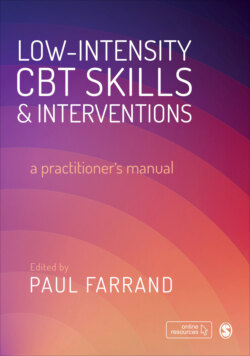Читать книгу Low-intensity CBT Skills and Interventions - Группа авторов - Страница 164
На сайте Литреса книга снята с продажи.
Decision 3: How Should the Intervention Be Delivered?
ОглавлениеTo improve access and acceptability (Richards, 2010a), LICBT intervention delivery can be supported across a number of different formats (Chapter 7). New technologies, including phone-based apps, are also rapidly developing and being implemented in Step 2/3 settings to augment and support treatment (Bennion et al., 2017). However, more research is needed to determine efficacy prior to full implementation (Leigh and Flatt, 2015).
Despite the potential of telephone- and computerised-CBT to improve access and promote choice for patients, LICBT practitioners may be ambivalent about such formats compared to face-to-face delivery (Meisel et al., 2018). This may be rooted in perceptions that telephone and computerised delivery will have a negative impact on the therapeutic relationship, treatment outcomes and patient levels of satisfaction and perceived acceptability (Turner et al., 2018). However, the evidence base highlights these modalities to be equivalent with respect to dropout and acceptability (Boyden and Dobel-Ober, 2016; Tutty et al., 2010). In some cases, LICBT interventions supported over the telephone have been reported to demonstrate greater effectiveness than face-to-face support (Farrand and Woodford, 2013). Similar findings have been reported for computerised-CBT compared to control conditions with respect to outcomes and acceptability (Andrews et al., 2018). Acceptability of computerised-CBT may be enhanced for those with concerns over confidentiality (Vallury et al., 2015). Given the range of interventions and delivery methods available, a collaborative decision should therefore be reached regarding the most suitable option. The COM-B model (Michie et al., 2011) may aid decision-making, specifically to determine if any factors related to Capability, Opportunity and/or Motivation are evident that may affect engagement with a specific modality or format (Chapter 8).
